This week offered much better weather for farmers. The summer bounty is beginning and many crops are looking good. On the other hand, as a pessimist I need to point out that some of the impact of the extreme weather (extremely hot or extremely wet) that filled most every day of the summer until this week are now showing up. I am seeing weather related problems such as blossom end rot in summer squash and tomatoes (wet or dry), stunted corn (loss of N), and dead buds in broccoli (heat). Late blight is being reported, but only pretty far away in places like PA, NY, OH and WV. There are no new reports in the Northeast. Squash bug eggs are hatching and if you are going to spray for this pest, the small nymph stage is the time to do it. Spotted wing Drosophila trap numbers are climbing fast. I have not heard about impacted fruit yet, and hope not to. Last year by mid August much of the soft skinned fruit was in sad shape. To lessen the impact, harvest frequently and thoroughly, and get the fruit refrigerated or frozen quickly. See the July 11, 2013 issue of the Pest Report for more details about SWD.
In this issue of the Pest Report there is information about a few problems out there or coming to a farm near you soon:
Buckeye Rot of tomato
Hornworms
Tarnished Plant Bug
Phytophthora Blight in cucurbits and peppers
Powdery Mildew in cucurbits
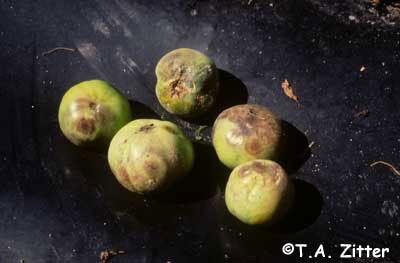 |
| Buckeye rot of tomato. Tom Zitter photo. |
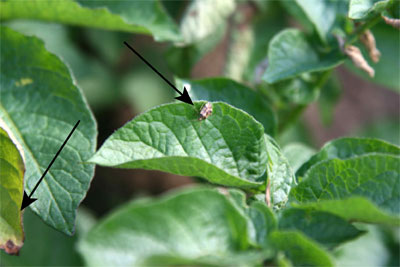 |
| Tarnished plant bug and leaf damage (lower left). |
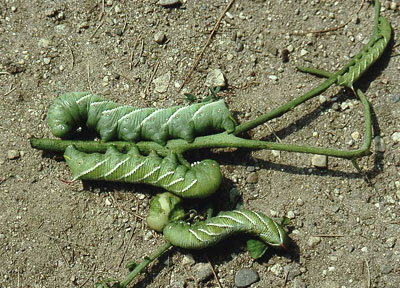 |
| Tomato hornworms. |
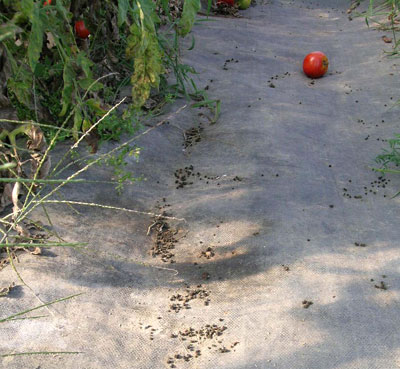 |
| Tomato hornworm frass below tomato plants. |
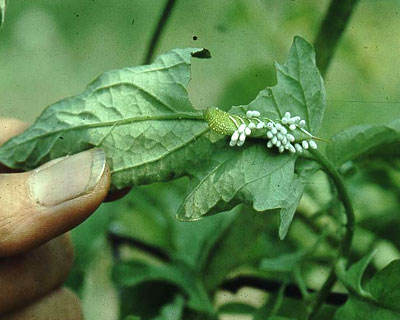 |
| Tomato hornworm hosting braconid wasp cocoons. Vern Grubinger photo. |
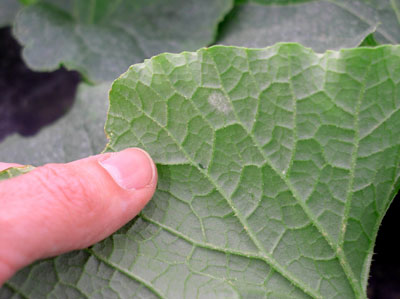 |
| Early symptoms of powdery mildew. |
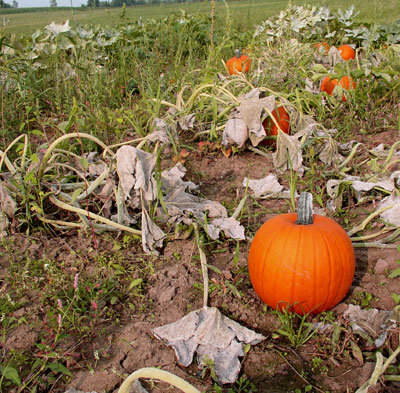 |
| Powdery mildew on pumpkins. |
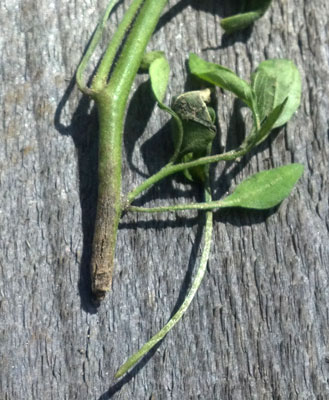 |
| Phytophthora blight on pepper stem. |
I have had two reports of what I believe is buckeye rot of tomato. It is not a very common disease, but occurs sometimes in warm, wet conditions. We have had warm, wet conditions this year.
It looks a tiny bit like late blight, and in fact the pathogen is in the same genus as late blight (Phytophthora), but it is a different species. The first symptom is a brown spot, which enlarges and may engulf more than half of the fruit with a brown lesion that is made up of concentric rings of light and dark brown. Unlike late blight, the pathogen does not impact the foliage.
The pathogen survives in the soil and is spread by moving surface water or spattering rain or irrigation. Avoid poorly drained soil. Reduce compacted soil. Low areas in a field are particularly prone to the problem. Rotation with crops not in the tomato family will help reduce the pathogen level in the soil. Staking and mulching helps.
The tarnished plant bugs, and other plant bugs, are rampant again this year. It is a small (6 mm), bronze, brown and black bug that feeds on a very wide variety of plants. They overwinter as adults under debris and become active early in the spring. The population size explodes in fields of hay. When the hay is cut the critters fly in search of food and end up on fruit and vegetables. There are three or more generations per season. They are serious pests on strawberries (causing cat faced berries), lettuce (browning of midrib), Celery (causing scars on the petiole), flowers (destroying buds), eggplant and pepper (destroying buds so there is no fruit), broccoli (brown beads in the head), and much more. In potato they basically kill flowers (who cares?) and damage some of the leaflets (minor problem). But I often get calls about the browning leaflets from folks who think it is late blight.
It is pretty easy to kill them with pyrethrum, but not worth it because their numbers are so great in all the fields of hay and weeds surrounding you that what you kill will be replaced in a day or two. Weeding and nearby field management is about all you can do to keep the numbers low. I do cover all of my peppers and eggplants with a floating row cover and leave that on well into June.
Hornworms are probably the most destructive insect attacking tomatoes and they are showing up now. They are giant caterpillars that can do a vast amount of eating in a very short time. Right now we are finding young, tiny ones. Sometimes it seems that overnight healthy looking tomato or pepper plants are stripped of their leaves leaving bare stems. The hornworms will also attack the fruit eating gouges out so large that they look more like bites of a furry animal than an insect.
Look now for the damage and the frass, which is black pellets laying all around plants hosting hornworms. The frass may be your first sign there is a problem. The frass of young hornworms is small. I don’t bother looking for the caterpillar because they blend in so well, I just look for the frass.
The adults are large, fast flying hawk moths, which in flight may look like a hummingbird. At dusk they hover over flowers sucking nectar. Eggs are laid on tomato leaves and hatch in 5 days.
Hand picking is a bit frightening but does work and chickens enjoy fighting with the challenging pest. The problem with hand picking is that they blend in very well and it is easy to overlook one or two caterpillars, which can do significant damage in a day or two. I just got a report this year from a grower who is using a black light at night and finding the worm shining.
Bt works very well on this caterpillar.
WHAT ARE THOSE WHITE THINGS ON TOMATO HORNWORMS?
Tomato hornworm larvae are parasitized by a number of insects. One of the most common is a small braconid wasp, Cotesia congregatus. Larvae that hatch from wasp eggs laid on the hornworm feed on the inside of the hornworm until the wasp is ready to pupate. The cocoons appear as many small white projections protruding from the hornworm’s body. Parasitized hornworms should be left in the field to conserve the beneficial parasitoids. The wasps will kill the hornworms when they emerge from the cocoons and will seek out other hornworms to parasitize. (Note: Picture is reprinted from a 2005 Vermont Veg and Berry News by Vern Grubinger.)
Powdery mildew is a common disease of pumpkins and winter squash. All cucurbits are susceptible, but many common cucumber and melon varieties are resistant. The disease can cause infected leaves to die prematurely, reducing yields and lowering fruit quality, especially taste. Winter squash from diseased plants won’t store as long as fruits from healthy plants. The fungus that causes the disease does not overwinter in Maine. Spores blow up every year from southern overwintering sites. If they arrive late in the season, you may not need any control; but if they arrive in early to midsummer, exercise some control or you may have no leaves by mid-August, or bland starchy squash.
I am just seeing the first powdery mildew now. This may warrant attention. Go out and scout. Check upper and lower surfaces of leaves of older plants every few days starting now. The first symptoms usually are white, powdery fungal patches on the undersides of older leaves. Yellow spots may form opposite these, on the upper leaf surfaces.
No products with systemic activity (products that move through the plant) are approved for organic production, and applying fungicide to the lower leaf surface is difficult. In experiments, foliar applications of sulfur have been more effective than most other organic products for powdery mildew, apparently because sulfur deposited on the upper leaf surface can volatilize and be redistributed to the lower surface. Sulfur can be phytotoxic on melons, especially if applied when temperatures are hot.
There are some new products made from potassium bicarbonate (Kaligreen and Milstop are two of these) that are showing good efficacy. For a good discussion of these, including efficacy, see the new edition of the Resource Guide to Organic Insect and Disease Management at: https://web.pppmb.cals.cornell.edu/resourceguide/
ATTRA (National Sustainable Agriculture Information Service, (https://www.attra.ncat.org) reports that a single spray application (to runoff) of 0.5 percent (wt./vol. of water) baking soda, plus 0.5 percent (vol./vol. of water) SunSpray UFP® horticultural oil almost completely inhibited powdery mildew on heavily infected pumpkin foliage; while baking soda without the oil was ineffective, and a 2 percent (wt./vol. of water) solution of baking soda damaged the leaves.
PHYTOPHTHORA BLIGHT ON PEPPER AND CUCURBITS
I recently received a few reports of phytophthora blight on pepper, and assume I will get some on cucurbits too. This is a disease caused by a pathogen in same genus as late blight (Phytophthora), but it is a different species. The problem only arises in wet areas in a field, which this year there are many of. Some years it is a very serious problem with pepper, eggplant, cucurbit and bean production. The plant will collapse as the pathogen attacks the roots and crown and girdles the stem. Fruit will rot where they touch the ground, or from spores carried by splashing water land on it. In cucurbits there is a white, yeast-like growth on the fruit.
The pathogen can be introduced on produce purchased from other farms, on shared equipment, and on irrigation or flood water. It lives in the soil and can persist many years. There are no materials that manage this disease and so control is based on cultural practices. A three year crop rotation to non host crops is recommended. All practices that prevent wet soil help (raised beds, choosing well drained fields, creating water ways, using drip instead of overhead irrigation, etc.).
